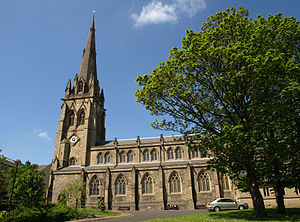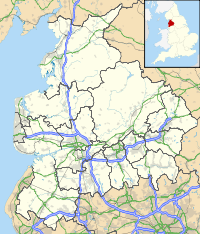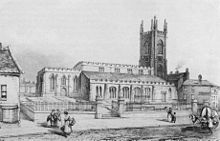- St John's Minster, Preston
-
St John's Minster Church of St John the Evangelist 
St John's Minster from the southLocation in Lancashire Coordinates: 53°45′31″N 2°41′46″W / 53.7585°N 2.6962°W OS grid reference SD 542 294 Location Church Street, Preston, Lancashire Country England Denomination Anglican Website City Parish of Preston History Dedication Saint John the Evangelist Architecture Status Parish church Functional status Active Heritage designation Grade II* Architect(s) E. H. Shellard Architectural type Church Style Gothic Revival Specifications Materials Sandstone, slate roofs Administration Parish Preston St. John and
St. George The MartyrDeanery Preston Archdeaconry Lancaster Diocese Blackburn Province York Clergy Vicar(s) Fr Timothy Lipscomb Assistant priest Fr Andrew Teather Laity Organist(s) Lyndon Hills Churchwarden(s) Rosemary Jolly, Arthur Packer, Judy Royan, Audrey Packer,
Sue Taylor, Margaret Warwick-Nelson, Norman WhittleSt John's Minster, formerly the Church of St John the Evangelist, is located in Church Street, in the centre of Preston, Lancashire, England. From its origin it has been the parish church of Preston. It is an active Anglican church in the deanery of Preston, the archdeaconry of Lancaster and the diocese of Blackburn. Its benefice is united with that of St George, Preston.[1] St John's has been designated by English Heritage as a Grade II* listed building.[2]
Contents
History
St John's stands on an ancient Christian site, originally dedicated to Saint Wilfrid. The church is not specifically mentioned in the Domesday Book, the earliest documentary reference being in 1094, when it was part of a grant by Roger de Poiteau to the abbey at Sées. None of the fabric of this church has survived. It was replaced by a new church, probably in the 16th century.[3] In 1581 its dedication was changed to Saint John the Baptist.[4] It was repaired during the following century, but by 1770 its condition had deteriorated.[3] In that year its dedication was changed again, this time to Saint John the Evangelist.[4] In 1811 the tower was partly demolished,[3] to be replaced by new tower in 1814.[5] However by 1853 the church was in such a bad condition that, apart from the base of the tower, the whole church was demolished.[3] The new church was built between 1853 and 1855; it was designed by E. H. Shellard, and it is considered to be his major work.[6] In 1856 the Lancaster architect E. G. Paley added groining to the tower and designed a font.[7] North and south galleries were removed in the 1960s.[2] The church was re-ordered in the early 2000s by Francis Roberts.[6][8] To mark the granting of city status to Preston, in 2003 the church was renamed the Minster Church of Saint John.[9]
Architecture
Exterior
The church is constructed in sandstone ashlar with slate roofs. Its plan consists of a 5½-bay nave with a clerestory, north and south aisles, a three-bay chancel with a two-bay organ-house to the north, a three-bay chapel on the south with an attached vestry, and a west steeple with a north porch. Its architectural style is Decorated. The buttressed tower is tall and in three stages. On its west face is a small two-light window in the bottom stage, and a lancet window in the middle stage. On the north and south sides are diamond-shaped clock faces. In the top stage are two louvred bell openings on each side, each with a crocketed gablet. Above them is a cornice with gargoyles, and a parapet with corner pinnacles. The pinnacles are linked by flying buttresses to smaller pinnacles clasping the spire. The spire is tall and octagonal. At the base of the spire are two-light lucarnes with gablets, and above these are two tiers of small lucarnes. To the north of the tower is a two-storey gabled porch. In its lower storey is a doorway flanked by crocketed niches, and in the upper storey is a two-light window flanked by blind windows.
Along the sides of the clerestory are buttresses rising to pinnacles, each bay containing a pair of two-light windows, with a single-light window in the half bay. At the east end is a pair of octagonal pinnacles. Along the sides of the aisles are buttresses rising to gablets, and each bay contains a large three-light window. At the east end of the chancel are diagonal buttresses rising to pinnacles. The east window is large with five lights. On the north side of the chancel is a thee-light window, and a parapet with open zig-zag work. The organ house has three-light windows on its north side, a large four-light window on the east side, and corner pinnacles. The features of the south chapel are similar. The vestry has a west door, a three-light east window and coupled lancets on its side.[2]
Interior
The arcades in both the nave and chancel are carried on quatrefoil piers. Both the nave and chancel have hammerbeam roofs. At the west end of the church is a gallery supported by timber piers.[2] The altar is by Francis Roberts, and it incorporates the base of an older pulpit. The east end of the north aisle forms a regimental chapel, and is separated from the rest of the aisle by iron screens decorated with red roses; it dates from the later part of the 20th century and was made by Trapp Forge. On the west wall of the church is a large painting of the Sermon on the Mount executed in 1956 by Hans Feibusch. In the baptistry is a painting dated 2003 by George Melling. The stained glass includes windows by William Wailes dating from the 1850s and, under the tower, a window by Shrigley and Hunt dated 1907.[6]
The earliest memorial is a brass dated 1623.[6] Elsewhere there are memorials to members of the Hoghton family, and in the tower is the tomb-recess of Thomas Starkie Shuttleworth who died in 1819.[2] There is also a wall monument by J. Theakston to Revd Roger Carus Wilson, who died in 1839, carved with reliefs of the five Preston churches built during his incumbency.[2][6] The thee-manual organ, dating from 1864, was rebuilt in 1872 by Gray and Davison.[10] In 1889 it was rebuilt by William Hill and Son and moved from its position in the west gallery to the north of the chancel.[11] The organ was rebuilt in 1965 by Hill, Norman & Beard, and repairs were carried out by Harrison & Harrison in 1972.[12] In 1989 David Wells carried out a comprehensive rebuilding.[13] The ring consists of twelve balls. These were all cast Whitechapel Bell Foundry, eight in 1920, two in 1997 and two in 2003.[14]
External features
The gates to the churchyard and the gates are listed at Grade II. They date from about 1855 and were probably designed by Shellard.[15]
Present day
St John's Minster, the Church of St George the Martyr, and the Chapel of Christ the King, together form the City Parish of Preston.[16] The parish covers the centre of the city of Preston.[17] Services are held regularly in all the churches.[18] Following the re-ordering of the 2000s, the building has been made more suitable for community, arts and cultural uses.[8]
References
- ^ St John (The Minster), Preston, Church of England, http://www.achurchnearyou.com/preston-st-john-the-minster/, retrieved 24 August 2011
- ^ a b c d e f Church of St John the Divine, Preston (1292457). National Heritage List for England. English Heritage. Retrieved 24 August 2011.
- ^ a b c d Hunt 1992, pp. 24–25.
- ^ a b St John's Minster, The City Parish of Preston, http://prestoncityparish.org/StJohnsMinster.aspx, retrieved 25 August 2011
- ^ Timmins 1992, p. Image 6.
- ^ a b c d e Hartwell & Pevsner 2009, p. 310.
- ^ Price 1998, p. 76.
- ^ a b Preston Minster, Francis Roberts Architects, http://www.francisroberts.com/category/religious-building/preston-minster/, retrieved 24 August 2011
- ^ Preston Saint John's Receives 'Minster' Status, Ringing-Online, http://www.rvc.me.uk/ringing/Preston/news.html, retrieved 24 August 2011
- ^ Lancashire, Preston, St. John the Evangelist (N10711), British Institute of Organ Studies, http://www.npor.org.uk/cgi-bin/Rsearch.cgi?Fn=Rsearch&rec_index=N10711, retrieved 25 August 2011
- ^ Lancashire, Preston, St. John the Evangelist (N10712), British Institute of Organ Studies, http://www.npor.org.uk/cgi-bin/Rsearch.cgi?Fn=Rsearch&rec_index=N10712, retrieved 25 August 2011
- ^ Lancashire, Preston, St. John the Evangelist (N10713), British Institute of Organ Studies, http://www.npor.org.uk/cgi-bin/Rsearch.cgi?Fn=Rsearch&rec_index=N10713, retrieved 25 August 2011
- ^ Lancashire, Preston, St. John the Evangelist (N12477), British Institute of Organ Studies, http://www.npor.org.uk/cgi-bin/Rsearch.cgi?Fn=Rsearch&rec_index=N12477, retrieved 25 August 2011
- ^ Preston, Minster Ch of S John Ev, Dove's Guide for Church Bell Ringers, http://dove.cccbr.org.uk/detail.php?searchString=preston&Submit=+Go+&DoveID=PRESTON+LJ, retrieved 25 August 2011
- ^ Gate piers and gates to churchyard opposite east end of Church of St John, Preston (1207262). National Heritage List for England. English Heritage. Retrieved 24 August 2011.
- ^ Welcome, The City Parish of Preston, http://prestoncityparish.org/default.aspx, retrieved 24 August 2011
- ^ About us, The City Parish of Preston, http://prestoncityparish.org/aboutus.aspx, retrieved 25 August 2011
- ^ Mass times, The City Parish of Preston, http://prestoncityparish.org/MassTimes.aspx, retrieved 25 August 2011
- Bibliography
- Hunt, David (1992), A History of Preston, Preston: Carnegie, ISBN 0-948789-67-0
- Hartwell, Clare; Pevsner, Nikolaus (2009) [1969], Lancashire: North, The Buildings of England, New Haven and London: Yale University Press, ISBN 978-0-300-12667-9
- Price, James (1998), Sharpe, Paley and Austin: A Lancaster Architectural Practice 1836–1942, Lancaster: Centre for North-West Regional Studies, ISBN 1-86220-054-8
- Timmins, Geoffrey (1992), Preston: A Pictorial History, Chichester: Phillimore, ISBN 0-85033-826-3
Categories:- Grade II* listed churches
- Grade II* listed buildings in Lancashire
- Church of England churches in Lancashire
- Gothic Revival architecture in Lancashire
- Religious buildings completed in 1855
- 19th-century Anglican church buildings
- Buildings and structures in Preston
Wikimedia Foundation. 2010.


